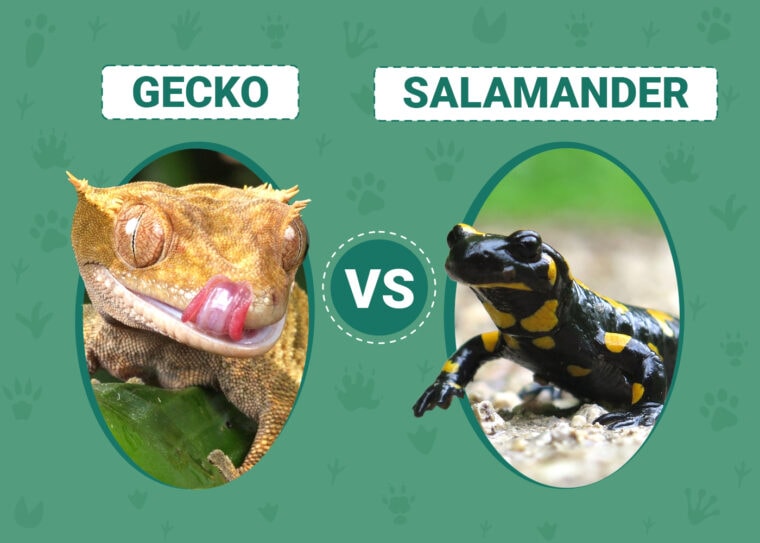
Click to Skip Ahead
Geckos and salamanders have similar body styles, and they are about the same size, but that’s where the similarities between the two end. The gecko is a reptile, and there are over 1,500 species of geckos, while the salamander is an amphibian with over 550 species. If you see one of these creatures and you are near the water, there’s a good chance that you are looking at a salamander. If you are not near water, it’s more likely to be a gecko.
Visual Differences

At a Glance
Gecko Overview

Environment and Habitat
The gecko is a reptile and can survive far from a water source. Most species like to live in trees in warmer environments, but you can find them almost anywhere in the world. Geckos lay hard-shell eggs that keep the moisture inside, enabling them to survive in even arid environments. When owning a gecko as a pet, you will need to provide them with plenty of space and places to climb and hide. You may need to use a heat lamp.
Health and Care
Of the more than 1,500 species of gecko, only a few are common pets, including the Giant Day Gecko, White Lined Gecko, Central American Banded Gecko, Frog-Eyed Gecko, and Leopard Gecko. Many breeds have long lifespans, with some reaching 20 years old. It has few health problems but will require a moderate amount of maintenance. You will need to clean and disinfect the habitat regularly and keep it at the proper temperature and humidity, and you may also need to help the gecko with its shedding.

Suitable For:
Geckos are best suited for warm climates with plenty of sunshine but can live long lives anywhere if you are vigilant about keeping their environment at the right temperature. Most have sticky pads on their feet that enable them to climb glass and walls, so it could be dangerous to have this pet around cats and other animals if there is a risk of escape. However, their long lifespan means you’ll have a companion for quite a while, and they are especially fascinating to small children.
Salamander Overview

Environment and Habitat
As amphibians, most salamanders spend their lives near or in water, though there are a few terrestrial species. Those that leave the water remain on the shoreline of ponds, lakes, and rivers. However, they do not take to saltwater. While salamanders do like warm environments, you can often find them in cooler climates than you might find a gecko. Salamanders are nocturnal carnivores that can detach their tail if a predator attacks them. Salamander eggs are soft and need to stay in the water to prevent them from drying out.
Health and Care
You usually keep salamanders in an aquarium with various water amounts, depending on what species you have. Most like to swim and then rest on the sand, so you will need to create that tank environment. In most cases, you will also need to regulate the humidity and clean the aquarium once a week, but you shouldn’t need to do much more, as salamanders are easy to maintain. Although some only live about 5 years, others have a longer life expectancy of 10 to 20 years.

Suitable For:
Salamanders are suitable for most homes and are quite adaptable. However, their adaptability makes them illegal in certain areas because they can become a threat to the ecosystem if they were to get out. It’s best to check with the local authorities before purchasing a salamander to make sure it’s legal.
Some salamanders excrete a toxin that can be harmful to other salamanders in the same tank, and it can also harm small children if they handle them, so you will need to not mix species and to lay down a few house rules. However, like geckos, they make great long-term pets that are fascinating to children, and since they don’t usually try to escape their cage, it’s generally safe to have them around other pets, even cats and dogs.
Summary
Both the salamander and the gecko make great family pets. Salamanders swim and look cute, while geckos like climbing the walls. If this pet is for a small child or your first pet, we recommend going with a salamander because it’s easier to care for and is slightly more adaptable to cooler temperatures. However, if your child plans to handle it, you have your heart set on this lizard, or salamanders are illegal in your area, get a healthy gecko instead. The only downside to these pets is that both are nocturnal, so they will be most active while you sleep.
We hope that you have enjoyed reading this comparison and that it has answered any questions that you had.
Featured Image Credit: Top – torstensimon, Pixabay | Bottom – Juli18, Pixabay











